BOUTIQUEResouces
Proper plate washing operation is crucial for reducing variability and eliminating background interference in ELISA assays. If you are using automated plate washing equipment or if the variability of your assay results is higher than expected, we hope the following articles and videos will help you optimize your experimental workflow and ensure that your assay results return to normal.
Advantages of Manual Plate Washing
Although the goal of ELISA plate washing is to remove unbound reactants, excessive washing can cause the dissociation of antibodies from target proteins to varying degrees, leading to low absorbance values and high %CV (Coefficient of Variation) values. In addition, incomplete removal of residual liquid (which usually occurs in automated plate washing equipment) can also result in higher detection background—these issues are particularly detrimental to HCP (Host Cell Protein) ELISA assays, as they inherently have relatively high baseline absorbance values.
Therefore, Cygnus experts recommend using the manual plate washing method as much as possible when using Cygnus ELISA kits. This method is simple and easy to learn, requiring no special equipment. You only need to prepare some low-fiber absorbent paper and a wash bottle to operate it easily. It should be noted that the outlet of the wash bottle should be trimmed into a large-opening bevel to ensure sufficient flow of the washing solution and appropriate washing intensity.
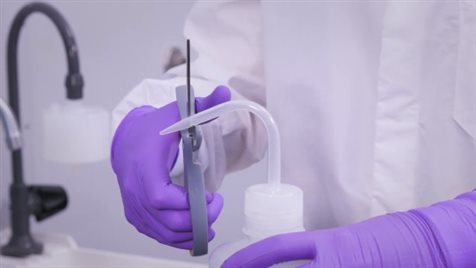
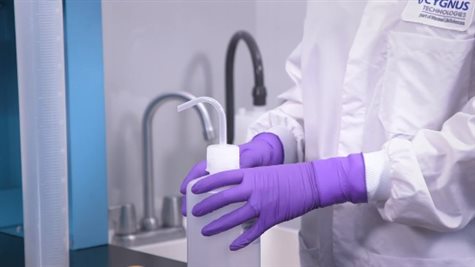
Trim the outlet of the wash bottle
Preparation Work: Dilute the Washing Solution and Prepare the Plate Washing Work Area
Dilute the 20× concentrated washing solution to 1× working concentration with distilled water, then fill it into the wash bottle. Spread the absorbent paper on a clean workbench next to the sink.
Note: Do not use any washing solution other than the one provided in the ELISA kit, as this may affect the assay results.
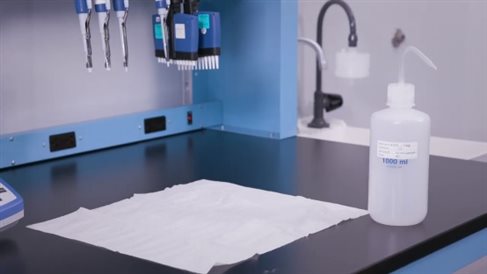
Step 1: Pour Out the Liquid from the ELISA Plate
Press the middle of one side of the ELISA plate with your thumb and the other side with your index finger, then hold the plate from the bottom. You can hook the plate strips or the labels at both ends of the strips with your thumb and index finger to prevent the strips from falling out of the plate holder. Quickly flip the plate over the sink, move your arm rapidly downward with force and stop suddenly—ensure the movement is smooth, allowing the liquid to be thrown into the sink by inertia. When operated correctly, no liquid should get on your fingers, the plate strips, or the outer side of the plate holder. Then repeat this pouring action once.
Note: If you are concerned about the plate strips falling out of the plate holder, you can mark the position of each plate strip in advance.
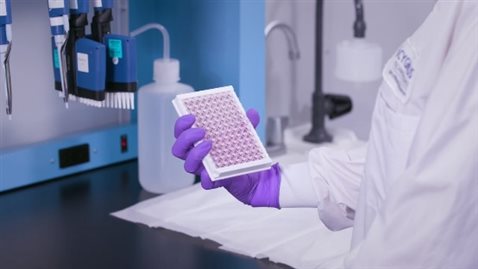
Step 2: Blot Residual Liquid with Absorbent Paper, Then Tap the Plate Gently
Immediately press the inverted plate onto the absorbent paper. Move the plate to an unused area of the absorbent paper and tap it gently three times, ensuring each tap is performed on a fresh (unused) section of the paper. Do not tap the plate with excessive force—too much tapping force will transmit uneven impact energy across the plate, leading to the dissociation of antibody/analyte complexes.
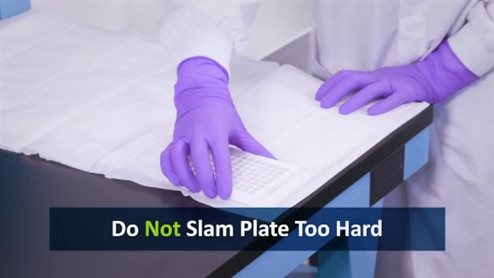
Step 3: Wash the Plate
Using a wash bottle filled with 1× washing solution, start from one upper side of the plate and fill each well with the washing solution until it overflows, continuing this process until the last well is filled. Then, discard the washing solution and tap the plate gently following the methods described in Steps 1 and 2.
Note: There is no need to worry about the washing solution overflowing from the wells, but avoid allowing the washing solution to soak in the wells for an extended period.
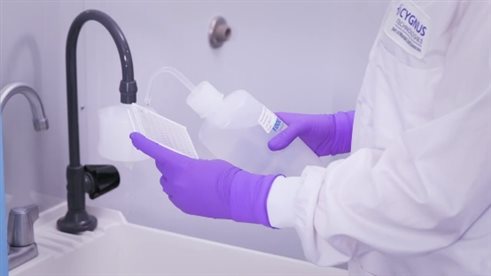
Repeat the above steps 3 times, resulting in a total of 4 plate washing operations. It is important to note that during the 2nd and 4th washes, add the washing solution to each well in the opposite direction, starting from the lower side of the plate. This operation ensures that the total soaking time of the washing solution in all wells is approximately the same. Additionally, there is no need to increase the number of washing cycles unnecessarily, as this may cause the analyte bound to the antibody to dissociate, leading to a decrease in detection sensitivity.
After the final wash, blot and tap the plate gently following the methods described in Steps 1 and 2. Then, invert the ELISA plate onto absorbent paper and let it stand for approximately 20 seconds to thoroughly drain any residual liquid. Finally, tap the plate 4 times on the absorbent paper.
Note: After each tap, it is advisable to rotate the plate horizontally by 180 degrees in your hand. This ensures that the force applied to both ends of the plate is more uniform.
Step 4: Wipe Off Excess Liquid
Use a clean piece of absorbent paper to wipe the outer bottom of the plate, removing any residual washing solution. Finally, place the washed ELISA plate back on the laboratory workbench and add the substrate.
Note: Do not allow the plate to dry completely, as this will affect the activity of the enzyme. Keep the substrate away from the sink—during the plate washing process, aerosols may be generated, which could contaminate the plate or the substrate and interfere with the assay results.
Finally, please watch the following plate washing operation video to help you quickly master this precise technique!
If you need the same type of wash bottle as shown in the video, please contact the staff of XMJ, or click here to fill in your information, and XMJ will get in touch with you as soon as possible.

Cygnus Technologies, LLC. provides products and analytical methods for the biotechnology and biopharmaceutical industries, aiming to accelerate the R&D phase and improve product quality. The bioprocess residual test kits developed and manufactured by Cygnus are used to detect specific impurities in more than 50 different expression systems. As an expert in high-sensitivity analytical technologies focused on immunoassays for biotechnological applications, Cygnus' products and services have been used by nearly all major biopharmaceutical companies for over 25 years.
![]()
As the exclusive general distributor of Cygnus in China, Beijing XMJ Technology Co., Ltd. has established long-term and stable cooperative relationships with numerous well-known domestic pharmaceutical companies and CRO/CMO enterprises. Over the years, XMJ’s products and services have helped many enterprises accelerate the R&D phase, improve drug quality, purity and safety, optimize R&D processes more quickly, shorten product time-to-market, and reduce QC costs. If you are interested in the above-mentioned products, please feel free to send email to info@xmjsci.com or visit the official website at www.gq44.cn for more information.


 京公網(wǎng)安備 11010802028692號
京公網(wǎng)安備 11010802028692號